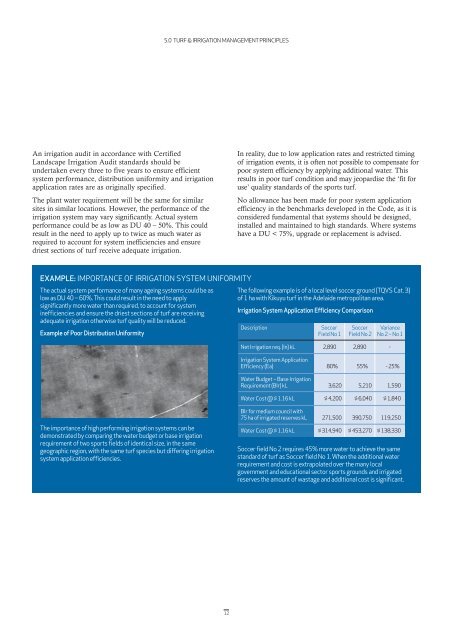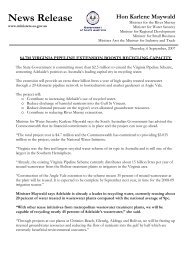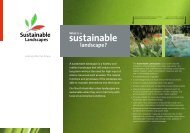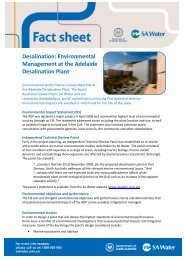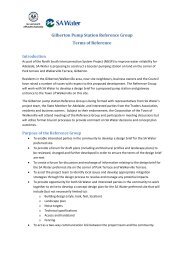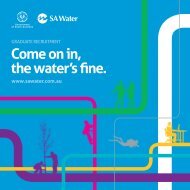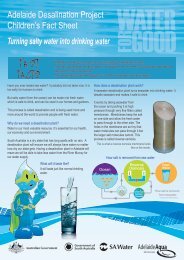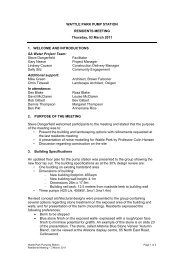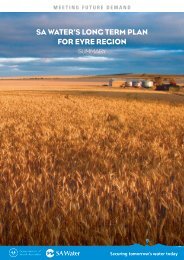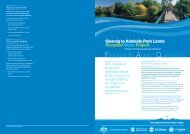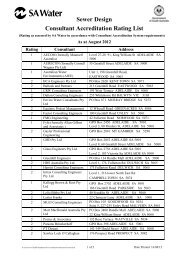Code of Practice - Irrigated Public Open Space - SA Water
Code of Practice - Irrigated Public Open Space - SA Water
Code of Practice - Irrigated Public Open Space - SA Water
You also want an ePaper? Increase the reach of your titles
YUMPU automatically turns print PDFs into web optimized ePapers that Google loves.
An irrigation audit in accordance with Certified<br />
Landscape Irrigation Audit standards should be<br />
undertaken every three to five years to ensure efficient<br />
system performance, distribution uniformity and irrigation<br />
application rates are as originally specified.<br />
The plant water requirement will be the same for similar<br />
sites in similar locations. However, the performance <strong>of</strong> the<br />
irrigation system may vary significantly. Actual system<br />
performance could be as low as DU 40 – 50%. This could<br />
result in the need to apply up to twice as much water as<br />
required to account for system inefficiencies and ensure<br />
driest sections <strong>of</strong> turf receive adequate irrigation.<br />
5.0 TURF & IRRIGATION MANAGEMENT PRINCIPLES<br />
EXAMPLE: IMPORTANCE OF IRRIGATION SYSTEM UNIFORMITY<br />
The actual system performance <strong>of</strong> many ageing systems could be as<br />
low as DU 40 – 60%. This could result in the need to apply<br />
significantly more water than required, to account for system<br />
inefficiencies and ensure the driest sections <strong>of</strong> turf are receiving<br />
adequate irrigation otherwise turf quality will be reduced.<br />
Example <strong>of</strong> Poor Distribution Uniformity<br />
The importance <strong>of</strong> high performing irrigation systems can be<br />
demonstrated by comparing the water budget or base irrigation<br />
requirement <strong>of</strong> two sports fields <strong>of</strong> identical size, in the same<br />
geographic region, with the same turf species but differing irrigation<br />
system application efficiencies.<br />
12<br />
In reality, due to low application rates and restricted timing<br />
<strong>of</strong> irrigation events, it is <strong>of</strong>ten not possible to compensate for<br />
poor system efficiency by applying additional water. This<br />
results in poor turf condition and may jeopardise the ‘fit for<br />
use’ quality standards <strong>of</strong> the sports turf.<br />
No allowance has been made for poor system application<br />
efficiency in the benchmarks developed in the <strong>Code</strong>, as it is<br />
considered fundamental that systems should be designed,<br />
installed and maintained to high standards. Where systems<br />
have a DU < 75%, upgrade or replacement is advised.<br />
The following example is <strong>of</strong> a local level soccer ground (TQVS Cat. 3)<br />
<strong>of</strong> 1 ha with Kikuyu turf in the Adelaide metropolitan area.<br />
Irrigation System Application Efficiency Comparison<br />
Description Soccer Soccer Variance<br />
Field No 1 Field No 2 No2–No1<br />
Net Irrigation req. (In) kL 2,890 2,890 -<br />
Irrigation System Application<br />
Efficiency (Ea) 80% 55% - 25%<br />
<strong>Water</strong> Budget – Base Irrigation<br />
Requirement (BIr) kL 3,620 5,210 1,590<br />
<strong>Water</strong> Cost @ $ 1.16 kL $ 4,200 $ 6,040 $ 1,840<br />
BIr for medium council with<br />
75 ha <strong>of</strong> irrigated reserves kL 271,500 390,750 119,250<br />
<strong>Water</strong> Cost @ $ 1.16 kL $ 314,940 $ 453,270 $ 138,330<br />
Soccer field No 2 requires 45% more water to achieve the same<br />
standard <strong>of</strong> turf as Soccer field No 1. When the additional water<br />
requirement and cost is extrapolated over the many local<br />
government and educational sector sports grounds and irrigated<br />
reserves the amount <strong>of</strong> wastage and additional cost is significant.


